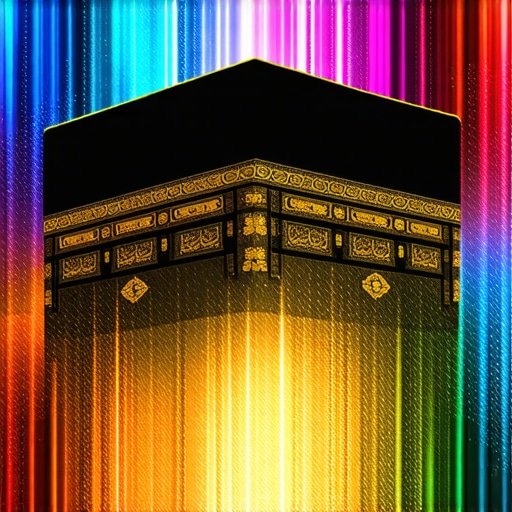My First Encounter with the Mysteries of True Dreams in Islam
Ever since I was young, I found myself captivated by dreams that felt more than mere sleep. I remember one night vividly, dreaming of a luminous light guiding me through darkness, which later turned out to be a divine message. This experience sparked my curiosity about how true dreams in Islam can serve as sacred messages from Allah. Over the years, I learned to discern these divine messages, which often appeared in symbolic forms, guiding me during moments of uncertainty.
Understanding the Sacred Significance of Dreams in Islamic Faith
In Islam, dreams are considered a significant aspect of divine communication. The Prophet Muhammad (peace be upon him) emphasized the importance of dreams as a means of divine guidance. According to Islamic teachings, true dreams—sometimes called Ru’yaa—can serve as prophetic signs or divine warnings. I often refer to authoritative sources like this detailed Islamic dream dictionary to help interpret these sacred visions, reinforcing my belief that dreams can carry profound spiritual messages.
How to Recognize Divine Messages in Your Dreams
One question I often pondered was: How do I distinguish between ordinary dreams and divine messages? Through personal experience and study, I found that divine dreams often have certain qualities—they feel clear, meaningful, and leave a lasting impression. They may also contain symbols that align with Islamic teachings. For example, dreaming of a mosque or Prophet Musa (Moses) can be a sign of spiritual guidance. I encourage everyone to keep a dream journal and seek knowledge from trusted Islamic scholars to better understand these divine signs.
What Are the Key Symbols That Indicate a True Dream in Islam?
Symbols such as light, water, and the Kaaba are often seen as sacred signs in dreams. Recognizing these symbols can help you interpret the message correctly. For instance, dreaming of water might symbolize spiritual purity or divine blessings, as explained in this article on spiritual nourishment. My advice is to look for consistency and clarity in dreams; these are often signs of divine origin.
If you’re seeking further insights, don’t hesitate to explore the rich resources available online or consult knowledgeable Islamic scholars. Sharing your dreams and reflections with a trusted community can also deepen your understanding and connection to divine messages. I invite you to leave a comment below with your experiences or questions about interpreting dreams in Islam—let’s learn together!
Decoding the Sacred Symbols of Dreams in Islam: An Expert’s Insight
Dream interpretation in Islam is a profound discipline that bridges the spiritual and the symbolic. As an expert in Islamic dream analysis, I often emphasize the importance of understanding the nuanced meanings behind common dream symbols. Recognizing sacred signs such as water, light, or specific colors can reveal divine guidance or prophetic messages, which are essential for spiritual growth and decision-making.
The Significance of Symbols: From Water to the Kaaba
Water, for instance, frequently appears in dreams as a symbol of spiritual purification and divine mercy, aligning with the teachings found in this resource on spiritual nourishment. Similarly, dreaming of the Kaaba is considered a sacred sign, often indicating divine favor or a forthcoming spiritual journey. These symbols serve as divine signals, guiding believers toward righteousness and piety.
How to Discern Authentic Divine Messages from Ordinary Dreams
Distinguishing between ordinary and divine dreams requires a keen eye and spiritual sensitivity. Authentic divine dreams typically possess clarity, consistency with Islamic teachings, and leave a profound impact on the dreamer. For example, experiencing a dream of Prophet Musa (Moses) or the Prophet Muhammad (peace be upon him) can be a sign of divine guidance, as discussed in this detailed article. It is advisable to keep a detailed dream journal and consult knowledgeable scholars to interpret these symbols accurately.

Understanding the context and symbolism of dreams enhances their interpretive power. As an expert, I recommend studying authentic Islamic texts and dream dictionaries, like this comprehensive guide, to deepen your insight into sacred dream symbols.
The Role of Colors and Numbers in Dream Symbols
Colors also carry significant meanings; for example, green often symbolizes paradise or divine blessing, while black may signify warnings or spiritual tests, as outlined in this detailed analysis. Additionally, numbers like 7 or 40 have spiritual connotations, frequently representing divine completeness or testing periods. Recognizing these signs requires a nuanced understanding of Islamic symbolism and divine linguistics.
What Are the Practical Steps to Enhance Your Ability to Recognize Sacred Dream Symbols?
Practical steps include maintaining a consistent dream journal, engaging in prayer (Salah) for clarity, and seeking knowledge from trusted Islamic scholars. Reflecting on dreams within the framework of Islamic teachings and prayer can also help discern divine messages. Sharing your dreams with knowledgeable others fosters community-based understanding and spiritual enrichment. Have you ever experienced a dream that later revealed a divine message? Share your story or questions below—learning from each other is a vital part of Islamic spiritual practice.
Unveiling the Layers of Sacred Symbols in Dreams: Personal Reflections
As I continue my journey into the fascinating world of Islamic dream symbolism, I find myself increasingly captivated by the layers of meaning that lie beneath each vision. Dreams like seeing water or the Kaaba are not merely surface symbols; they are gateways to deeper spiritual truths that require careful contemplation and sincere reflection. I recall a dream where I saw a bright, golden light illuminating a path—initially, it seemed simple, but upon studying Islamic interpretations, I realized it symbolized divine guidance and hope, especially during challenging times. This experience reinforced my belief that dreams can serve as profound spiritual messages, provided we approach them with humility and a sincere desire to understand.
How to Cultivate a Deeper Connection with Divine Messages in Your Dreams
Building a stronger connection with divine messages involves more than just passive observation. It requires active engagement—such as maintaining a detailed dream journal, praying for clarity, and seeking knowledge from trusted scholars. One practical step I found effective is to incorporate supplication (dua) before sleep, asking Allah for clear and beneficial visions. Additionally, reflecting on dreams through the lens of Quranic verses and teachings from the Prophet’s traditions helps anchor these visions in Islamic spirituality. Sharing dreams with knowledgeable companions or scholars can also illuminate hidden meanings that might elude us alone. Have you experienced a dream that challenged or transformed your understanding of your spiritual path? I invite you to share your stories or questions—our collective insights can deepen our spiritual growth.
The Nuances of Symbols: Beyond the Obvious
Sometimes, symbols in dreams are layered with multiple meanings, depending on context and personal circumstances. For instance, dreaming of a snake might signify danger or spiritual tests, but it could also represent hidden knowledge or spiritual awakening, especially if the snake appears in a positive or neutral context. According to Ibn al-Qayyim, understanding the context and the dreamer’s state is crucial in interpreting sacred symbols correctly (source). This nuance reminds me that dreams are not always straightforward; they often require spiritual sensitivity and contextual awareness. I encourage you to approach dream interpretation with patience, humility, and a sincere desire to understand Allah’s messages. If you’ve encountered complex symbols, please share your experiences or questions—our shared reflections can lead to deeper insights.
The Role of Colors and Numbers in Advanced Dream Interpretation
Colors and numbers in dreams carry sacred meanings that can enhance our understanding of divine messages. For example, green often symbolizes paradise, divine mercy, and spiritual growth, while black may denote spiritual tests or warnings, as detailed in this resource. Numbers like 7 or 40 are also significant, representing divine completeness or periods of testing, respectively. Recognizing these signs requires a nuanced understanding of Islamic numerology and symbolism. I have personally found that meditating on these symbols, especially in conjunction with prayer, amplifies their spiritual significance. Have you noticed particular colors or numbers recurring in your dreams? How have they influenced your spiritual journey? Feel free to share your insights or ask questions—our collective experiences enrich our understanding of divine symbolism.
Encouraging Personal Exploration and Continuous Learning
Ultimately, the journey of understanding dream symbols in Islam is ongoing and deeply personal. I encourage everyone to cultivate curiosity, patience, and humility as they explore these sacred visions. Resources like authentic Islamic dream dictionaries, scholarly writings, and community discussions can serve as valuable guides. Remember, dreams are a form of divine communication that requires sincere effort, prayer, and reflection to interpret correctly. As I continue to study and reflect, I realize that each dream offers an opportunity for spiritual growth and a closer connection to Allah. I invite you to embark on this journey of discovery—share your experiences, questions, or insights below. Together, we can deepen our understanding of the sacred messages Allah reveals to us through dreams.
Unveiling the Nuances of Dream Symbols: A Sacred Language
In my ongoing exploration of Islamic dream interpretation, I have come to appreciate the intricate layers of symbolism that each vision can carry. Dreams are not merely visual puzzles but are coded messages from the divine, requiring a refined understanding of sacred language. For instance, a dream featuring a snake might symbolize spiritual tests or hidden wisdom, depending on the context and the dreamer’s state, as discussed in this comprehensive resource. Recognizing these nuances demands not only scholarly knowledge but also spiritual sensitivity cultivated through sincere supplication and reflection.
Mastering the Art of Sacred Symbol Interpretation in Your Dreams
To refine your ability to decipher divine messages, I recommend cultivating a practice of meticulous dream journaling, combined with consistent prayer (Salah) for clarity. Engaging with trusted Islamic scholars and referencing authentic texts like the Islamic dream dictionary can deepen your understanding. Over time, this disciplined approach allows you to recognize patterns and symbols—such as water representing spiritual purification or the Kaaba signifying divine favor—that are key to discerning divine guidance from ordinary dreams.
How Can Colors and Numbers Reveal Divine Secrets?
Colors and numbers in dreams are sacred linguistics that encode divine truths. Green, for example, often signifies paradise and spiritual growth, while black might serve as a warning or test of faith, as elaborated in this detailed analysis. Numbers like 7 and 40 are potent symbols—representing divine completeness and testing periods, respectively. Understanding these signs requires a keen awareness of Islamic numerology, which can be cultivated through meditation and prayer. Have you noticed recurring colors or numbers in your dreams that seemed to carry profound messages? Sharing your insights can foster collective spiritual growth and deepen your interpretive skills.
Can Dream Symbols Change Meaning Based on Personal Circumstances?
Absolutely. A symbol’s significance often depends on the individual’s current spiritual state, life circumstances, and emotional well-being. For example, dreaming of a bird might symbolize liberation and hope, but in a different context, it could represent spiritual awakening or divine mercy. According to Ibn al-Qayyim, understanding the context and personal nuances is crucial for accurate interpretation (source). This layered approach reminds us that dreams are deeply personalized sacred messages, requiring humility, patience, and ongoing learning. Have you experienced a dream whose meaning evolved as your life circumstances changed? I invite you to reflect and share your journey, as it can enrich others’ understanding of divine symbolism.
What Practical Steps Can Elevate Your Dream Interpretation Skills?
Practicing mindfulness and continuous education are vital. Maintain a detailed dream journal, engage regularly in supplication (dua) before sleep to ask for divine guidance, and study Islamic texts on dream symbolism. Incorporating Quranic verses and prophetic traditions into your reflections strengthens your connection with divine messages. Participating in community discussions and seeking mentorship from knowledgeable scholars can further refine your skills. If you wish to deepen your understanding, exploring resources like Ibn Sirin’s Dream Dictionary can be invaluable. Do you have a memorable dream where divine guidance became clearer through study or prayer? Sharing your experience can inspire others on their spiritual journey.
Engaging with Sacred Symbols to Foster Spiritual Growth
Active engagement involves contemplating dreams within the framework of Islamic teachings, prayer, and reflection. For instance, praying for clarity upon waking, reciting Quranic verses related to dreams, or seeking guidance from scholars can illuminate hidden meanings. Personally, I have found that consistently asking Allah for insight (through dua) transforms dreams into powerful tools for spiritual refinement. Moreover, sharing dreams with trusted community members fosters collective understanding and spiritual bonds. Have you ever encountered a dream that challenged your beliefs or opened new spiritual horizons? I encourage you to share your stories or questions, as our collective insights serve as a beacon for spiritual enlightenment.
The Sacred Language of Colors and Numerology in Depth
Colors and numbers are not arbitrary; they are divine signs encoded in a sacred language. For example, the color green signifies divine mercy and paradise, while red might symbolize divine warnings or urgency, as explored in this detailed guide. Numerology also plays a key role; the number 7 is often associated with divine perfection, and 40 signifies testing or renewal. Recognizing these signs involves studying Islamic symbolism and numerology, complemented by prayer and reflection. Have you noticed particular colors or numbers recurring in your dreams that seemed to carry profound messages? Engaging with these signs consciously can dramatically enhance your spiritual discernment and connection with Allah’s divine plan.
Deepening Your Relationship with Divine Messages
Building a meaningful relationship with divine messages entails active listening, sincere supplication, and ongoing study. Incorporate prayer before sleep, asking Allah for clear visions, and dedicate time to meditate on dream symbols through Quranic verses and prophetic traditions. Reflecting on dreams within this sacred framework transforms them from mere visions into profound tools for spiritual growth. I have experienced moments where a dream guided me through uncertainties, reaffirming my faith and understanding. If you have encountered dreams that shifted your spiritual perspective, I invite you to share these experiences. Together, we can foster a community rooted in divine wisdom and mutual encouragement.
Things I Wish I Knew Earlier About True Dreams in Islam
The Power of Personal Reflection
Looking back, I realize that trusting my intuition and keeping a dream journal earlier could have deepened my understanding of divine messages. Personal reflection helps decode the subtle signs Allah sends us through dreams, making the spiritual journey more meaningful.
The Importance of Context
I used to overlook how much context influences dream interpretation. Recognizing the surrounding circumstances in my life, as well as symbols like water or the Kaaba, provided clarity and aligned my dreams with Islamic teachings, enriching my spiritual insight.
Patience in Interpretation
Initially, I wanted immediate answers, but I learned that divine messages often require patience and ongoing reflection. Taking time to study and pray helps unravel the deeper layers of sacred dreams, leading to authentic understanding.
Seeking Knowledge from Scholars
Connecting with knowledgeable Islamic scholars transformed my approach. Their guidance provided accurate interpretations, preventing misjudgments, and fostering a respectful, humble attitude towards divine signs.
The Role of Symbols and Colors
Discovering that symbols like water, light, and even colors such as green or black carry profound meanings in dreams has been eye-opening. Recognizing these signs can guide believers toward righteousness and divine favor, especially when studied through trusted sources.
Building a Dream Community
Sharing dreams with a community of believers created a supportive environment where collective insights could flourish. This practice strengthened my faith and helped me see divine messages from different perspectives.
Resources I’ve Come to Trust Over Time
- Islamic Dream Dictionary — This comprehensive guide has been invaluable for understanding symbols and themes in dreams, grounding my interpretations in authentic Islamic knowledge.
- Scholarly Works of Ibn al-Qayyim — His insights into spiritual tests and divine signs have deepened my appreciation for the sacred language of dreams in Islam.
- Online Islamic Forums — Engaging in discussions with other believers has expanded my understanding of diverse dream experiences and interpretations.
- Quran and Hadith Collections — These primary sources remain the foundation for recognizing divine guidance and sacred messages within dreams.
Parting Thoughts from My Perspective
Reflecting on the significance of true dreams in Islam, I believe that these visions can serve as powerful tools for spiritual growth when approached with humility and sincerity. Recognizing divine messages often requires patience, study, and community support. If this article resonates with you, I encourage you to keep a dream journal, seek knowledge, and remain open to the sacred signs Allah may reveal through your dreams. Sharing your experiences and questions can help foster a deeper collective understanding and strengthen our connection to divine guidance. Remember, every dream carries a potential message from Allah—approach them with reverence and trust in His wisdom.

